#Pliocene
Explore tagged Tumblr posts
Text

Act like Megalochelys atlas and smile, because it’s Fossil Friday! One of the largest known land turtles, scientists think this massive reptile could reach heights of 5.9 ft (1.8 m)—tall enough to look a grown human in the eye. This specimen’s shell measures some 7.4 ft (2.3 m) long and in life, it may have weighed more than 2,000 lbs (907 kg). Megalochelys lived during the Late Pliocene about 2 million years ago. The fossil on display in the Museum’s Hall of Vertebrate Origins was found in 1922 in Chandigarh, India.
Photo: © AMNH
#science#amnh#museum#fossil#nature#natural history#animals#paleontology#turtle#herpetology#did you know#fact of the day#pliocene#fossil friday#cool animals#turtles#smile#ancient animals#reptiles
2K notes
·
View notes
Text

It’s time to give the animals of the Cenozoic a day in the limelight…
#cenozoic mammals#cenozoic era#cenozoic#works in process#work in progress#work in process art#work in progress art#art wip#wip#mammoths#wooly mammoth#wooly rhino#smilodon#basilosaurus#andrewsarchus#brontothere#paraceratherium#deinotherium#hominids#paleocene#eocene#oligocene#miocene#pliocene#pleistocene#pleisotcene megafauna#paleogene#neogene#quaternary#megalodon
445 notes
·
View notes
Text

Welcome Ardenna buchananbrowni, a recently described diving shearwater from the Pliocene Tangahoe Formation of New Zealand
#paleoart#digital art#paleontology#digital illustration#pliocene#illustration#shearwater#ardenna buchananbrowni#Tangahoe formation
461 notes
·
View notes
Text

Another sketch brought to you by #paleostream
Thinobadistes was a large ground sloth living and potentially lived in mangroves in Florida. With all these algae in it's fur a manatee sneaks up on this one to brutally nibble on it.
1K notes
·
View notes
Text
Agapornis longipes Pavia et al., 2024 (new species)

(Limb bones [A–J] and a partial lower jaw bone [K] of Agapornis longipes [scale bar = 10 mm], from Pavia et al., 2024)
Meaning of name: longipes = long foot [in Latin]
Age: Pliocene–Pleistocene (Piacenzian–Gelasian)
Where found: Kromdraai, Cooper's Cave, and Swartkrans, Gauteng, South Africa
How much is known: Numerous limb bones and a partial lower jaw bone. It is unknown whether any of these bones belonged to the same individuals.
Notes: Agapornis is the genus of lovebirds, a group of small parrots from Africa. As its name suggests, A. longipes had a relatively longer foot than any other known species of lovebird, living or extinct. Extant lovebirds feed heavily on grass seeds, and species with relatively longer hindlimbs tend to collect this food resource from the ground, so it is plausible that A. longipes also foraged in this manner.
Reference: Pavia, M., J. Braga, M. Delfino, L. Kgasi, A. Manegold, C. Steininger, B. Zipfel, and A. Val. 2024. A new species of lovebird (Aves, Psittaculidae, Agapornis) from the Plio-Pleistocene of the Cradle of Humankind (Gauteng, South Africa). Geobios advance online publication. doi: 10.1016/j.geobios.2024.05.006
#Palaeoblr#Birblr#Dinosaurs#Birds#Agapornis longipes#Pliocene#Pleistocene#Africa#Telluraves#2024#Extinct
79 notes
·
View notes
Text

A fossilized shark tooth of a great white shark, or Carcharodon carcharias from the Pisco Formation in Sacaco, Peru. This Pliocene aged great white shark tooth shows nice shades of blue colors known from this deposit.
#fish#shark#chondrichthyan#fossils#paleontology#palaeontology#paleo#palaeo#carcharodon#great white shark#pliocene#cenozoic#prehistoric#science#paleoblr#ホホジロザメ#カルカロドン#ネズミザメ科#サメ#化石#古生物学
42 notes
·
View notes
Text
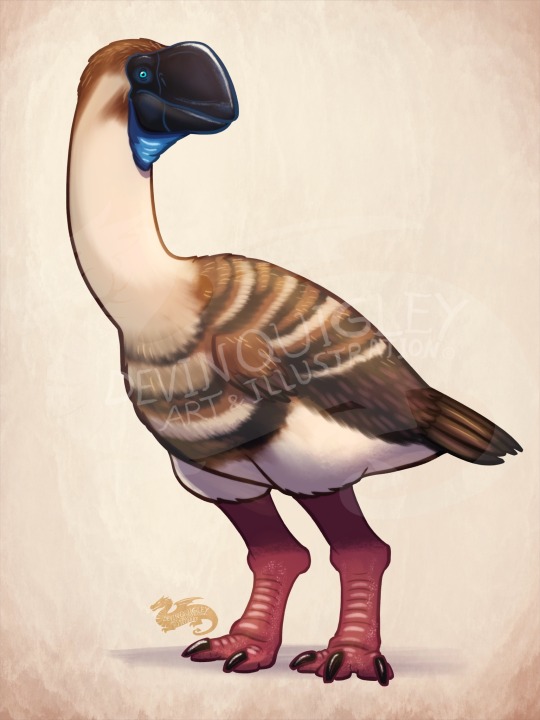
Paleovember 2023, Dromornis!
Staying in Australia for a bit, turns out emus and cassowaries weren't always the only large birds to worry about down under! Dating back to the Pliocene, the genus Dromornis were titans of their time and place, with one species in particular, D. stirtoni, estimated to grow up to ten feet tall, making it the largest bird to ever exist! It's powerful beak and jaws allowed it to cut and crush vegetation (though it likely also scavenged on occasion).
#dromornis#mihirung#australia#pliocene#bird#flightless birds#prehistoric#art challenge#illustration#paleontology#paleoart#art#artwork#cartoon#digitalart#drawing#procreate#artist on tumblr
174 notes
·
View notes
Text
youtube


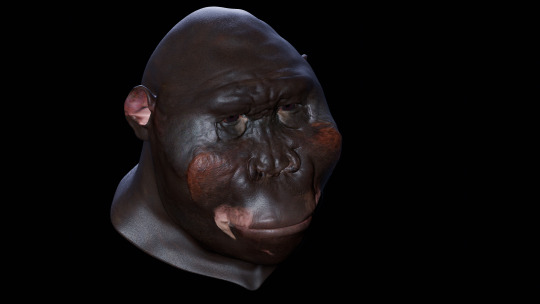
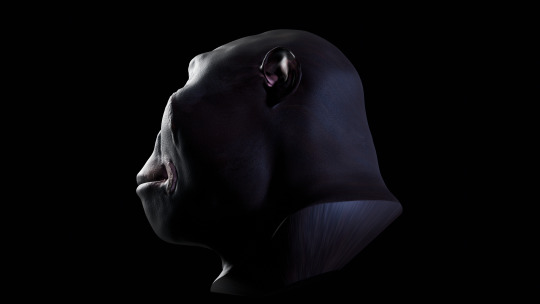




I've been working on 9 different Hominin reconstructions in Blender, and now I finally finished this Paranthropus boisei bust, reconstructed over a scan of fossil skull OH 5 provided by MorphoSource. The "skin" here is my significant modification of "free_basemesh_head_woman" created by Mono on SketchFab, because that had much better topology than I could make from scratch. These eight images are exported directly from Blender via a variety of camera setups, and the video fades between three additional versions of all these, including a Solid viewport shading option and a reveal of the underlying muscles, bone, and cartilage. Color and Displacement textures created in Photopea, 3d Object rendered in Blender, and video created with Clipchamp, 2024-25. More Hominins to come! Eventually!
#Blender#Digital Sculpture#3d Rendering#UV Texturing#Hominin#Human evolution#Paranthropus boisei#robust Australopiths#extinct primates#OH 5#Olduvai Hominin 5#MorphoSource#Blender Camera Export#video#Youtube#fossil reconstruction#craniofacial anatomy#paleoart#paleosculpture#bust#Pliocene#Tanzanian prehistory#Christopher Maida Artwork
22 notes
·
View notes
Text

For a while now I've wanted to draw a terror bird but haven't until now
64 notes
·
View notes
Text
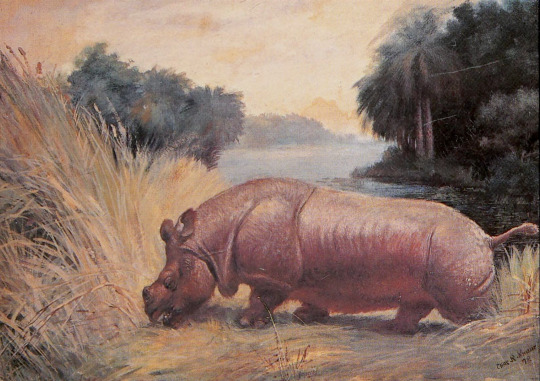
Teleoceras, Charles R. Knight, 1878
Teleoceras has a cold. His nose is gobbled up with mucous and a bitter taste coats the walls of his mouth. None of the grass tastes sweet. He sneezes and litters the reeds with a cloud of germs and snot particles. His eyes are puffy. The world looks as if it's in a haze. He blinks, tries to clear his vision, feels thick tears leak from the corners of his eyes. A cough shakes his body, brings up a wad of phlegm that he instinctively swallows down with a moan. If any predator were to stalk him, they would turn away in disgust.
90 notes
·
View notes
Text

Yesterday, an earthquake shook the narrow coastal lands between the Atlantic Ocean to the west and the great dry abyss to the east. A landslide allowed the water to break through the narrow strip of high land and begin flooding in. The incredible power of the ocean violently widened the gap and eroded the lowlands beyond, creating an ever growing chasm and the biggest waterfall on the planet by the next day.
With the very ground under their feet unsure and brittle and the sea rushing in ever faster, some of the local animals have fled to the top of a large nearby rock outcropping that will one day be named Gibraltar. The only ones who don't seem disturbed are the Pelagornis and other sea birds, who have discovered some aerial acrobatics let them catch the fish being swept up in the flood. Though even for a bird the size of Pelagornis, an unfortunate humpback whale is way too big of a catch.
The vast, dry salt plains beyond continue much further than any of the watching animals can imagine, yet a thousand Amazons worth of water will fill up the abyss within a year or two. In the process, the Mediterranean Sea, which had dried up completely a million years before, will be reborn.
#neogene#pliocene#zanclean flood#pelagornis#gerbil#mouse#wall lizard#macaque#humpback whale#Odontopterygiform#bird#rodent#primate#mammal#flood#gibraltar#my art#paleoart#palaeoblr#miocene#messinian salinity crisis#according to some definitions this would be the second day of the pliocene#i have not been to gibraltar myself so i had to rely on google earth for references of the view of the other side#cw: animal death
95 notes
·
View notes
Text
A Brief History of Flamingos
People wanted it so here it is, a brief rundown of flamingos throughout prehistory, which is essentially a brief summary of extinct flamingo species that I worked on for Wikipedia. Because of this, I'll stick to the two main famillies, the Palaeolodidae ("swimming flamingos") and Phoenicopteridae (true flamingos) and leave aside the misc. early forms we don't know are actually related or not.
Palaelodidae Palaelodids, occasionally referred to as "swimming flamingos" are an interesting and surprisingly long lasting group, containing 3 genera, 10 species and ranging from the Oligocene to the Pleistocene across all continents bar Africa and Antarctica.
The oldest palaelodid is Adelalopus hoogbutseliensis from the Early Oligocene of Belgium. Not much to be said other than that its name is an anagram of Palaelodus.
Palaelodus is the most widespread of the genera in the family, with the type species being Palaelodus ambiguus from the Oligocene and Miocene of Europe. I did actually make a whole post about the genus before here. Anyways, P. ambiguus is the best known species thanks to the ample material collected at Saint-Gérand-le-Puy, France. Remains were also found in Germany and maybe Brazil?
Brazil is interesting, because already by the Oligocene palaelodids were nearly cosmopolitan. Two other species, Palaelodus pledgei and Palaelodus wilsoni, have been recovered from the Oligocene to Miocene of Australia, half a world away from P. ambiguus. P. pledgei is the smallest known species of Palaelodus.
During the early Miocene we also get Palaelodus aotearoa, from New Zealand, and from the middle Miocene Palaelodus kurochkini from Mongolia. The later of the two may in fact be its own genus, but for now its deemed Palaelodus.
Generally, Palaelodus is less specialised than flamingos, though living in brackish waters and feeding on small aquatic insects, they didn't yet have the same suffisticated filter feeding bill as todays flamingos. Whats debated is how they moved. Some suggest wading, others diving and again others propose the idea that they may have been swimmers.
There is one more note on this group, which is that there are some remains assigned to P. wilsoni that appear to have been Pleistocene in age? Obviously this would be a massive deal, but it has also been suggested that this could be a new species given the time gap or a whole new genus. Still, palaelodid remains from the Pleistocene are still incredible. Palaelodus by Alphinyx and Tom Simpson


The last member of the Palaelodidae is Megapaloelodus. Yes they misspelled Palaelodus in the genus name. The definition of this form is kinda vague and mostly based on size, which is why there's so many issues around Megapaloelodus goliath. You see it was initially described based on its size, but when larger remains of Megapaloelodus were found it was transferred to that genus. However, all other Megapaloelodus species are from the Americas, so thats kinda odd, although of course not a dealbreaker. Still, future research might change things up here.
While Megapaloelodus goliath was contemporary and found at the same place as Palaelodus ambiguus, all others are found in Miocene to Pliocene deposits of America.
Megapaloelodus connectens is the type species and known from the Miocene of South Dakota and California.
Megapaloelodus peiranoi may be the basalmost species and was discovered in Miocene deposits of Argentina.
Finally, we got Megapaloelodus opsigonus from Oregon and possibly Baja California. As this is the youngest species, from the Pliocene, its name means "born in a later age".
Megapaloelodus by Joschua Knüppe (with Argentavis) and Scott Reid

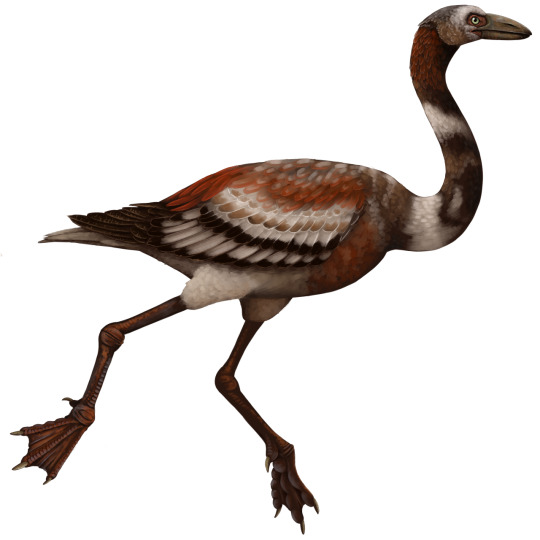
Which actually wraps up palaelodids. Yeah the majority of studies are focused on palaelodids, no surprise given its the only one with really good remains. But based on said animal, its a fascinating group.
This means we can move on to true flamingos, members of the family Phoenicopteridae. I hope you like that name btw, because goddamn "Phoenico" is an overused prefix for these animals to a ridiculous degree. Even I struggled keeping up.
Just to set the stage, lets establish the modern flamingos, split into two to three genera. There is the Lesser Flamingo (Phoeniconaias minor), the only extant member of its genus and native to Africa and Asia. There are two species of Phoenicoparrus, the Andean and Jame's flamingos (Phoenicoparrus andinus and Phoenicoparrus jamesi respectively), both endemic to South America. And then there's the three species of Phoenicopterus. The incredibly whidespread Greater Flamingo (Phoenicopterus roseus), the American Flamingo (Phoenicopterus ruber) and the Chilean Flamingo (Phoenicopterus chilensis). As if the Greater and American flamingos didn't already have latin names way too similar, they were also synonyms for a while so thats fun when they get brought up in old papers.
Chart of living flamingos by Mr. Gharial

Anyways, lets reset to the Oligocene and do this semi-chronologically as before. And yes, Oligocene. Because contrary to what you might think, palaelodids, as we currently think of them as, aren't the ancestors to flamingos and more a really weird sister group that appeared from the same common ancestor aroundt he same time.
Thankfully, we get to start with something fun and not confusing, Harrisonavis croizeti. Another one I did actually cover in detail on Tumblr right here. The short of it is that Harrisonavis already bears the hallmarks of modern flamingos, possessing that classic curved bill and certainly doing some filter feeding already. And if you paid attention you might recognize where its from. Saint-Gérand-le-Puy, France. Yup, this guy coexisted with Palaelodus and Megapaloelodus. Must have been a fascinating place.
Harrisonavis and Palaelodus by Joschua Knüppe
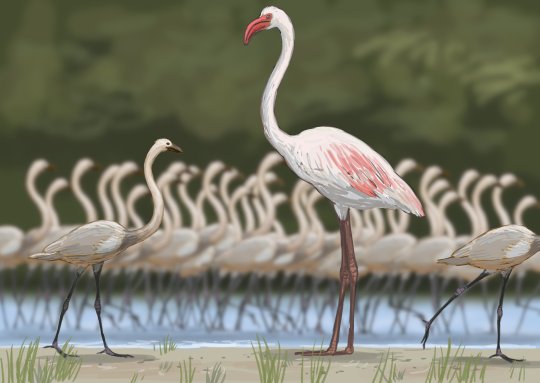
Of course this being a well known form, we gotta follow it up with something bad. Elornis is, simply put, a mess. We aren't even super sure if its a flamingo or not and its history is convoluted. All we can say for sure is that it lived during the late Oligocene in France.
Like palaelodids, true flamingos seem to have dispersed rapidly, as our next entry managed to reach Australia by the late Oligocene. Phoeniconotius eyerensis, I repeat that one, PhoenicoNOTIUS (you see what I mean with things getting confusing?) is a genus from the Lake Eyre Basin of South Australia. It was a comparably robust animal, much more massive than other flamingos and perhaps more of a wader than a swimmer, staying away from deeper waters?
Same time same place we got Phoenicopterus novaehollandiae. PhoenicoPTERUS, as in the same genus as American and Greater flamingos. Now this guy sticks mostly to the same stuff as its relatives, thus differing clearly from Phoeniconotius.
Phoeniconotius (foreground), Phoenicopterus novaehollandiae (?, middle) and palaeolids (background) by Frank Knight, Phoeniconotius by Anne Musser
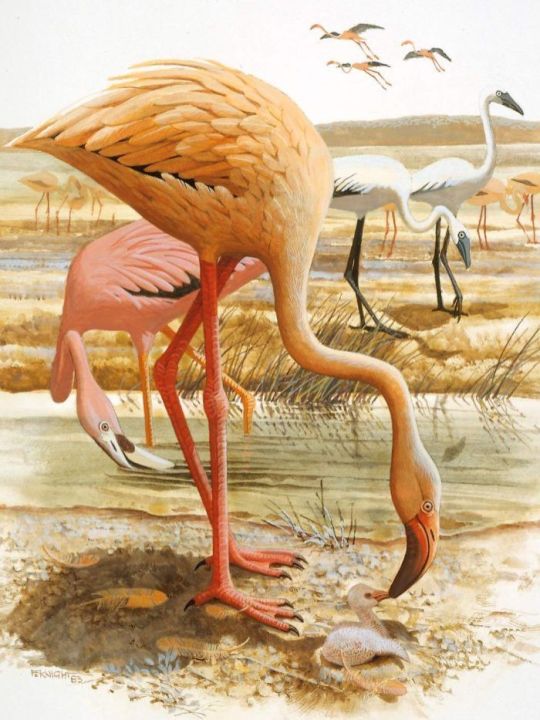
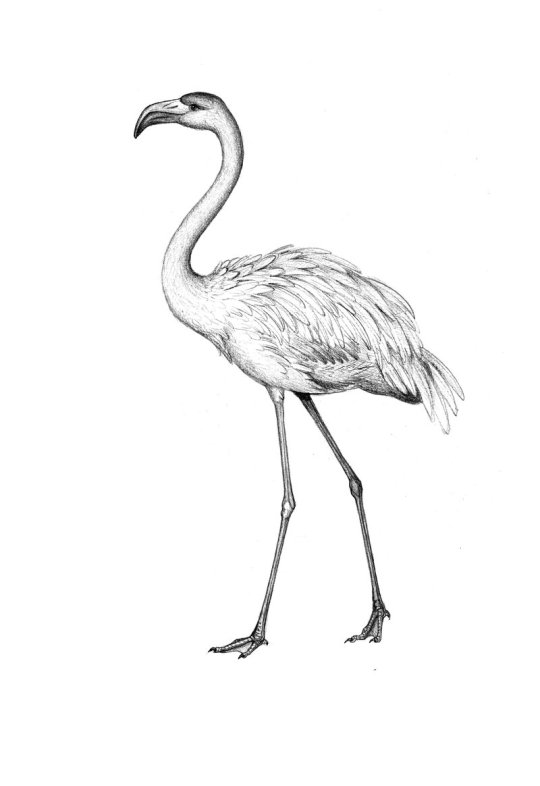
We can now move into the Miocene. We get a brief break from Phoenico names courtesy of Leakeyornis aethiopicus from Kenya. Tho its not super well preserved, its among the few fossil flamingos with known skull remains, so thats gotta count for something.
Skeletal by me, art by Joschua Knüppe

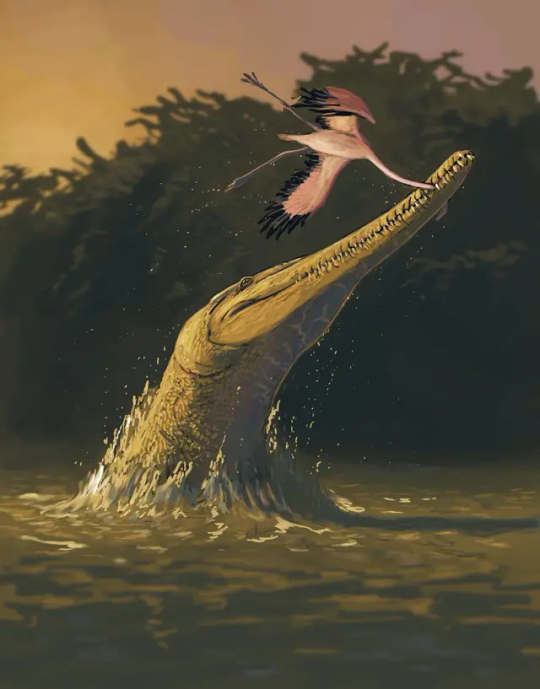
Also during the Miocene, we get the appearance of the genus Phoeniconaias (PhoenicoNAIAS) thanks to Phoeniconaias siamensis. A small species, only slightly larger than today's Lesser Flamingo, its remains are exclusively known from the Mae Long Reservoir in northern Thailand.
Fossil material of P. siamensis alongside a Lesser Flamingo via เบิร์ดโบราณ - Ancient bird on Facebook
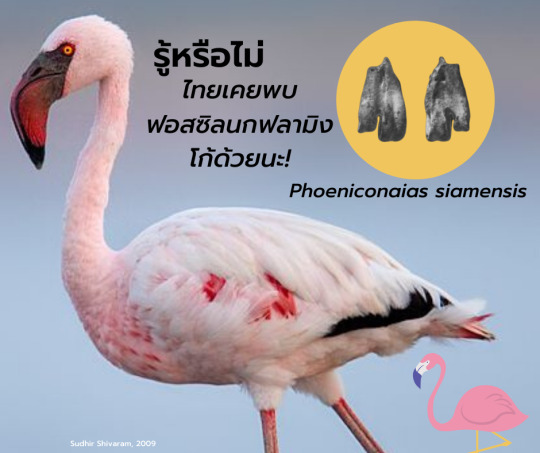
And already we find ourselves in the Pliocene. Oh how time flies. Lets wrap up known fossil species of Phoeniconaias then while we're at it. Phoeniconaias proeses is a species from Australia. Unlike our friend from Thailand, this one is actually smaller than its modern relative. It also coexisted with two other flamingos. Fossils from the region have been assigned to the Greater Flamingo and one other form we'll cover next.
Xenorhynchopsis. Our last truly original name. Xenorhynchopsis minor is the older of the two, Pliocene in age and the species I just alluded to earlier. The genus then went on to continue into the Pleistocene via Xenorhynchopsis tibialis. Neither is especially well known and both had been named by de Vis, who while no doubt an important contributor to Australian paleontology also had plenty of flaws I'll discuss soon with my next post on mekosuchines. Anyways, Xenorhynchopsis has a cool name, a confusing history (they were described as storks) and likely died out when the inland waterways of Australia dried up.
Its all downhill from here folks. It's all PhoenicoPTERUS from now on and none of them are especially good. Lets rewind to the Pliocene to cover them properly.
We got Phoenicopterus floridanus from the early Pliocene of, who guessed it, Florida. It may have also inhabited North Carolina.
Phoenicopterus stocki, or Stock's Flamingo, lived during the middle Pliocene in Mexico. Tho not well described, we got juvenile remains too, young individuals that were not yet capable of flight.
Finally we got two Pleistocene species.
Phoenicopterus minutus from California, specifically Lake Manix. Lake Manix also yielded fossils tentatively assigned to the other Pleistocene fossil species.
Phoenicopterus copei. While fossils of P. minutus are currently exclusive to Lake Manix, P. copei was more widespread, ranging from Mexico in the south to Oregon in the north as well as California in the west and Florida in the east. Where it coexisted with other flamingos, like P. minutus and American flamingos, it would have been the larger species.
And thats it. All the fossil flamingos of the Palaelodidae and Phoenicopteridae. Alas, bird fossils preserve notoriously poorly and though stuff like the ends of tibiatarsi and tarsometatarsi are diagnostic, they aren't super helpful to making them sound interesting to the average joe. So sorry if this whole post is a little dry in spots.
#palaelodidae#phoenicopteridae#palaelodus#megapaloelodus#adelolepus#leakeyornis#harrisonavis#elornis#phoenicopterus#phoenicoparrus#phoeniconaias#phoeniconotius#xenorhynchopsis#palaeoblr#paleontology#prehistory#oligocene#miocene#pliocene#pleistocene#cenozoic#flamingo#phoenicopteriformes#long post
164 notes
·
View notes
Text

“In the course of twenty million years, mammals got more and more successful until they were the biggest, fiercest, and most spectacular animals on the planet. Whatever the climate, whatever the habitat, mammals made it their own. Their great strength was their ability to adapt. They grew to gigantic sizes, they evolved into powerful killers like the famous sabre-tooth cats, and they even laid claim to the oceans.”
- Kenneth Branagh, prologue to “Walking with Beasts”
Sketches of some of the incredible wildlife of the Cenozoic Era. None of the animals are exactly shown to scale. From left to right, bottom to top:
Arctocyon, Barylambda, Coryphodon, Titanoboa
Uintatherium, Notharctus, Mesonyx, Eobasileus
Leptictidium, Gastornis, Propaleotherium, Titanomyra, Godinotia, Pakicetus, Ambulocetus
Apidium, Arsinotitherium, Andrewsarchus, Embolotherium, Moeritherium, Dorudon, Basilosaurus, Perucetus
Megacerops, Cainotherium, Merycoidodon
Cynodictis, Paraceratherium, Hyaenodon gigas, Chalicotherium, Paraentelodon
Gentilicamelus, Amphicyon, Daeodon, Moropus, Dinocrocuta, Platybelodon, Gomphotherium, Pelagornis, Purussasaurus, Odobenoceratops, Otodus megalodon
Phoruschracos, Astrapotherium, Teleoceras, Synthetoceras, Samotherium, Livyatan
Australopithecus afarensis, Deinotherium, Ancylotherium, Dinofelis
Mammuthus columbi, Smilodon fatalis, Bison latifrons, Aenocyon dirus, Arctodus simus, Panthera atrox, Titanotylopus, Equus hersternus, Sivatherium, Gigantopithecus, Paleoloxodon
Smilodon populator, Macrauchenia, Doedicurus, Megatherium, Glyptodon, Toxodon
Mammuthus primigenius, Megaloceros giganteus, Coelodonta antiquitatis, Bos primigenius, Homo neanderthalensis, Elasmotherium, Bison bonasus
#paleoart#paleontology#cenozoic mammal#cenozoic animals#cenozoic mammals#cenozoic era#cenozoology#cenozoic#palaeontology#paleoartist#artists on tumblr#paleoartists on tumblr#paleoblr#paleogene#neogene#quaternary#paleocene#eocene#oligocene#miocene#pliocene#pleistocene#palaeoart#paleo#palaeoblr#paleoillustration
55 notes
·
View notes
Text

Thylacosmilus atrox - A saber-toothed predatory marsupial from South America that lived around 9-3 million years ago.
#Thylacosmilus#paleoart#paleontology#evolution#animal art#animals#zoology#marsupial#marsupials#miocene#pliocene#mammals#mammal#cenozoic
18 notes
·
View notes
Text



Epochtober Day 3: Pliocene (Semirostrum) 🐬#procreate #digitalart #digitalpainting #semirostrum #pliocene #epochtober #paleontology #paleoart
#digitalart#ipadpro#procreate#art#paleontology#paleoart#semirostrum#Pliocene#digital painting#Epochtober
20 notes
·
View notes
Text
Marocortyx Zelenkov, 2024 (new genus)

(Type humerus [upper arm bone] of Marocortyx africana [scale bar = 10 mm], from Zelenkov, 2024)
Meaning of name: Marocortyx = Morocco Ortyx [defunct genus name for the northern bobwhite, now in the genus Colinus]
Species included: M. africana (type species, previously in Plioperdix), M. novaki (previously in Palaeocryptonyx)
Age: Pliocene (Piacenzian)
Where found: Ahl al Oughlam, Casablanca-Settat, Morocco and Las Higueruelas, Castilla–La Mancha, Spain
Notes: Marocortyx was a phasianid, a group that includes chickens, partridges, and turkeys. In particular, it appears to have been closely related to Afro-Eurasian quails and rock partridges. The two named species of Marocortyx were previously assigned to different extinct phasianid genera, but a new study finds that they are more similar to one another, and reclassifies both of them in a new genus. In fact, the two species are so similar to each other that they may actually represent a single species, the main difference being that M. africana was slightly larger than M. novaki.
Reference: Zelenkov, N.V. 2024. The diversity and evolution of quails and allies (Aves: Galliformes: Phasianidae: Coturnicini) in the Miocene–Early Pleistocene of Eurasia. Paleontological Journal 58: 1089–1193.
27 notes
·
View notes